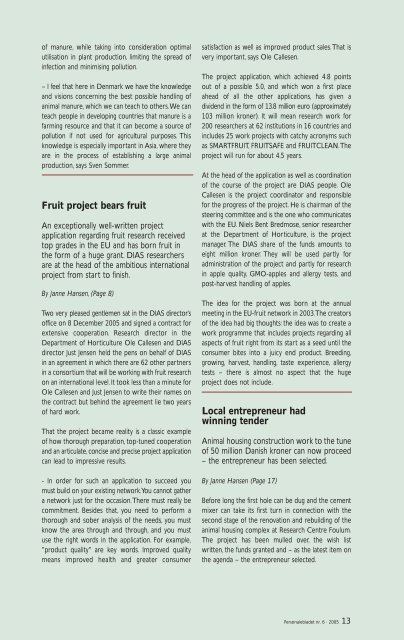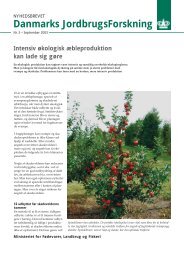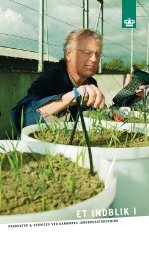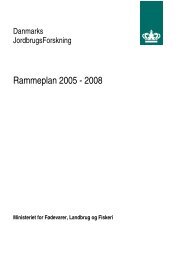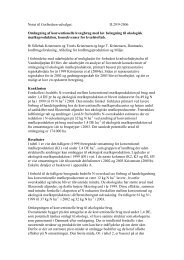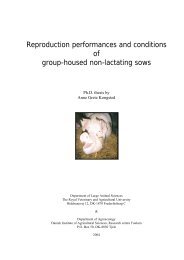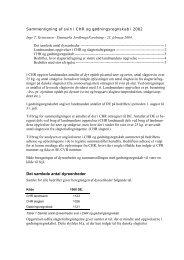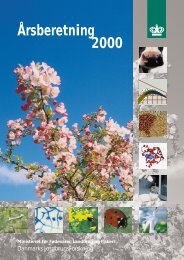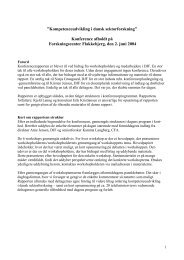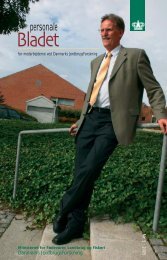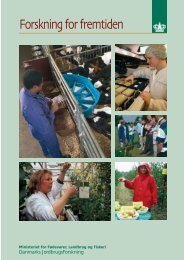Bladet - DCA - Nationalt Center for Fødevarer og Jordbrug
Bladet - DCA - Nationalt Center for Fødevarer og Jordbrug
Bladet - DCA - Nationalt Center for Fødevarer og Jordbrug
Create successful ePaper yourself
Turn your PDF publications into a flip-book with our unique Google optimized e-Paper software.
of manure, while taking into consideration optimal<br />
utilisation in plant production, limiting the spread of<br />
infection and minimising pollution.<br />
– I feel that here in Denmark we have the knowledge<br />
and visions concerning the best possible handling of<br />
animal manure, which we can teach to others.We can<br />
teach people in developing countries that manure is a<br />
farming resource and that it can become a source of<br />
pollution if not used <strong>for</strong> agricultural purposes. This<br />
knowledge is especially important in Asia, where they<br />
are in the process of establishing a large animal<br />
production, says Sven Sommer.<br />
Fruit project bears fruit<br />
An exceptionally well-written project<br />
application regarding fruit research received<br />
top grades in the EU and has born fruit in<br />
the <strong>for</strong>m of a huge grant. DIAS researchers<br />
are at the head of the ambitious international<br />
project from start to finish.<br />
By Janne Hansen, (Page 8)<br />
Two very pleased gentlemen sat in the DIAS director’s<br />
office on 8 December 2005 and signed a contract <strong>for</strong><br />
extensive cooperation. Research director in the<br />
Department of Horticulture Ole Callesen and DIAS<br />
director Just Jensen held the pens on behalf of DIAS<br />
in an agreement in which there are 62 other partners<br />
in a consortium that will be working with fruit research<br />
on an international level. It took less than a minute <strong>for</strong><br />
Ole Callesen and Just Jensen to write their names on<br />
the contract but behind the agreement lie two years<br />
of hard work.<br />
That the project became reality is a classic example<br />
of how thorough preparation, top-tuned cooperation<br />
and an articulate, concise and precise project application<br />
can lead to impressive results.<br />
- In order <strong>for</strong> such an application to succeed you<br />
must build on your existing network.You cannot gather<br />
a network just <strong>for</strong> the occasion.There must really be<br />
commitment. Besides that, you need to per<strong>for</strong>m a<br />
thorough and sober analysis of the needs, you must<br />
know the area through and through, and you must<br />
use the right words in the application. For example,<br />
”product quality” are key words. Improved quality<br />
means improved health and greater consumer<br />
satisfaction as well as improved product sales.That is<br />
very important, says Ole Callesen.<br />
The project application, which achieved 4.8 points<br />
out of a possible 5.0, and which won a first place<br />
ahead of all the other applications, has given a<br />
dividend in the <strong>for</strong>m of 13.8 million euro (approximately<br />
103 million kroner). It will mean research work <strong>for</strong><br />
200 researchers at 62 institutions in 16 countries and<br />
includes 25 work projects with catchy acronyms such<br />
as SMARTFRUIT, FRUITSAFE and FRUITCLEAN.The<br />
project will run <strong>for</strong> about 4.5 years.<br />
At the head of the application as well as coordination<br />
of the course of the project are DIAS people. Ole<br />
Callesen is the project coordinator and responsible<br />
<strong>for</strong> the pr<strong>og</strong>ress of the project. He is chairman of the<br />
steering committee and is the one who communicates<br />
with the EU. Niels Bent Bredmose, senior researcher<br />
at the Department of Horticulture, is the project<br />
manager. The DIAS share of the funds amounts to<br />
eight million kroner. They will be used partly <strong>for</strong><br />
administration of the project and partly <strong>for</strong> research<br />
in apple quality, GMO-apples and allergy tests, and<br />
post-harvest handling of apples.<br />
The idea <strong>for</strong> the project was born at the annual<br />
meeting in the EU-fruit network in 2003.The creators<br />
of the idea had big thoughts: the idea was to create a<br />
work pr<strong>og</strong>ramme that includes projects regarding all<br />
aspects of fruit right from its start as a seed until the<br />
consumer bites into a juicy end product. Breeding,<br />
growing, harvest, handling, taste experience, allergy<br />
tests – there is almost no aspect that the huge<br />
project does not include.<br />
Local entrepreneur had<br />
winning tender<br />
Animal housing construction work to the tune<br />
of 50 million Danish kroner can now proceed<br />
– the entrepreneur has been selected.<br />
By Janne Hansen (Page 17)<br />
Be<strong>for</strong>e long the first hole can be dug and the cement<br />
mixer can take its first turn in connection with the<br />
second stage of the renovation and rebuilding of the<br />
animal housing complex at Research Centre Foulum.<br />
The project has been mulled over, the wish list<br />
written, the funds granted and – as the latest item on<br />
the agenda – the entrepreneur selected.<br />
Personalebladet nr. 6 · 2005 13


